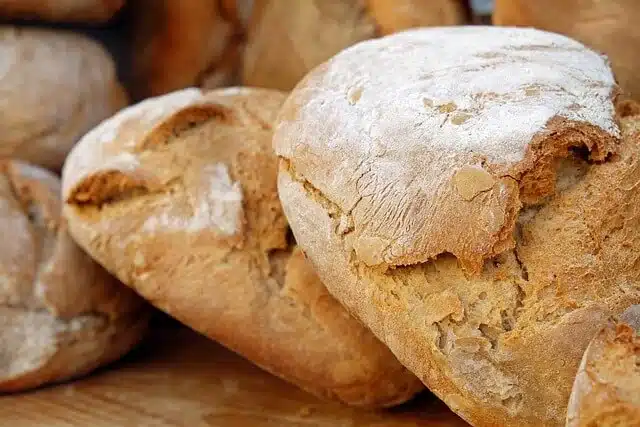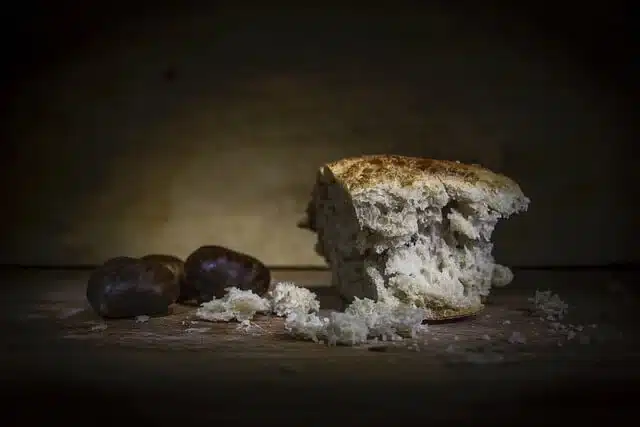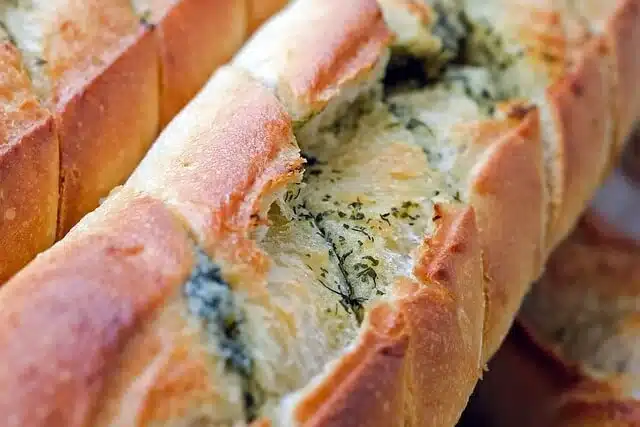The Spiritual Meaning of Bread in Various Cultures
In the tapestry of human culture, especially when considering Bread in Religious Festivals, few things are as universally significant as bread. This humble food, a cornerstone of diets worldwide, holds a spiritual nourishment that transcends its physical sustenance. In many traditions, bread is not just food; it’s a symbol of life itself, a gift from the divine, providing strength and sustenance to the body and soul, playing a pivotal role in various religious ceremonies.
For instance, in Christianity, bread takes on a sacred role during the Eucharist. It’s not merely a part of the ritual; it symbolizes the Body of Christ, offering spiritual nourishment and a profound sense of connection to the divine. This act of communion is a cornerstone of Christian faith, embodying the belief in Christ’s sacrifice and his ongoing spiritual presence in the lives of believers. Discover more about What Type of Bread is Good for Special Occasions to understand its significance in various cultures.
Bread Representing Connection and Communion with the Divine
The symbolism of bread extends beyond nourishment, serving as a powerful connector to the divine. In various religious practices, the act of breaking and sharing bread is a gesture of unity and fellowship, a physical manifestation of spiritual connection.
In Judaism, the Challah, a special braided bread, is central to the Sabbath and other holidays. Its intricate braids and sweet taste are not just culinary delights but represent the intertwining of spiritual life and the blessings from God. Sharing Challah within the family or community isn’t just a tradition; it’s a sacred act that reinforces bonds and expresses gratitude for divine providence.
Similarly, in Islamic culture, bread symbolizes more than sustenance. It’s a token of shared life and togetherness. During festivals and gatherings, the act of sharing bread reinforces social bonds and reflects a communal spirit, a fundamental aspect of Islamic teachings. Explore Middle Eastern Vegetarian Recipes: 12 Delicious Culinary Dishes to see how bread is incorporated in various dishes.
Bread in Christianity, Judaism, and Islam Eucharist in Christianity – Symbolizing the Body of Christ

In the heart of Christian worship lies the Eucharist, a sacrament rich in history and spiritual significance, integral to Bread in Religious Festivals. Here, bread transcends its earthly form, becoming a symbol of faith and redemption. For more on Eucharistic traditions, explore 5 Eucharistic Traditions at Mass and Their Meaning. During the Eucharist, the bread is consecrated, representing the Body of Christ. This act is a cornerstone of Christian belief, embodying the mystery of Christ’s sacrifice and his promise of eternal life.
The Eucharist is more than a ritual; it’s a profound expression of faith, a moment where the divine and human meet. Christians partake in this sacrament as a means of receiving spiritual nourishment and reaffirming their connection to Christ. It’s a communal act that unites believers in a shared experience of divine grace, echoing the Last Supper where Jesus broke bread with his disciples, a pivotal moment in Religious Festivals involving bread.
Challah in Judaism – Representing Sustenance and Blessings
In Judaism, bread, particularly Challah, holds a place of honor in religious and cultural life, symbolizing the essence of Bread in Festivals. This braided bread, traditionally baked for the Sabbath and Jewish holidays, is a symbol of God’s providence and generosity. The act of blessing and breaking Challah is a ritual that embodies gratitude, remembrance, and the cyclical nature of life.
Challah’s intricate braids are rich in symbolism, representing the intertwining of spiritual and material aspects of life. The bread’s sweetness and richness are reminders of the abundance and blessings bestowed by God. Sharing Challah within the family or community during Sabbath meals or festive occasions is not just a tradition; it’s a sacred act that reinforces Jewish identity and values, a core aspect of Religious Festivals with bread.
Bread in Islamic Traditions – Fostering Unity and Togetherness
In Islamic culture, bread, known as Khobz, is a symbol of sustenance and shared life, central to Bread in Religious Festivals. Its significance is particularly pronounced during Ramadan, the holiest month in the Islamic calendar. Breaking the fast with bread is a ritual that embodies humility, gratitude, and community spirit, reflecting the profound role of bread in Islamic Religious Festivals.
The sharing of bread during Ramadan and other special occasions is a gesture of unity and equality. It transcends social and economic differences, bringing people together in a shared act of worship and fellowship. In Islam, bread is more than a dietary staple; it’s a medium through which believers express their faith, generosity, and commitment to the community. Learn about Bread Additions: Creative Ways to Enhance Your Homemade Loaf for more ideas.
Symbolism and Metaphors of Bread
Bread Symbolizing Life, Death, and Transformation
Bread, in its essence, is a profound metaphor for the cycle of life, death, and rebirth. Across various cultures and religions, it represents the sustenance of life, the inevitability of death, and the hope of transformation. This symbolism is deeply rooted in the way bread is made – from the sowing of the grain to the baking of the loaf.
In many spiritual teachings, bread is used as a metaphor for divine wisdom and guidance. It’s seen as a source of spiritual sustenance that nourishes the soul, much like it nourishes the body. This metaphor extends to the concept of death and rebirth – the grain must fall and die to give life to new growth, just as bread must be broken to be shared and consumed.
Bread as a Metaphor for Spiritual Growth and Development
The process of making bread – mixing, kneading, fermenting, and baking – is often likened to personal and spiritual growth. It’s a journey of transformation, where simple ingredients come together to create something greater than their individual parts. This process can be seen as a metaphor for the spiritual journey, where experiences and teachings are assimilated to foster growth and understanding.
In many spiritual paths, the act of consuming bread is symbolic of internalizing divine wisdom and nourishment. It’s a reminder that spiritual growth requires both sustenance and effort, much like the cultivation and preparation of bread. This metaphor speaks to the heart of many faiths, where bread serves as a tangible connection to the divine, aiding in personal transformation and enlightenment.
The History and Symbolism of Bread in Religion
Tracing back to ancient civilizations, bread has always been more than mere sustenance; it’s a symbol deeply ingrained in the fabric of life and spirituality. To delve deeper into the historical aspects of bread in various religions, visit Bread, Religions, and Tradition. In ancient Egypt, for instance, bread was revered as a symbol of life itself. Tombs of the pharaohs often depicted scenes of bread making, signifying its importance in both life and the afterlife.
In Christianity, bread takes on a profound meaning, symbolizing the ‘Bread of Life’. This concept is central to Christian teachings, where bread is not only a reminder of physical life but also of spiritual life and eternal sustenance. The ritual of breaking bread, therefore, becomes a sacred act, embodying the essence of life and the promise of salvation.
Bread in Biblical Times – Baking and Breaking Bread
The significance of bread in biblical times cannot be overstated. It was a daily staple, but more importantly, it held deep spiritual and communal significance. The process of making bread – laboriously grinding grain, kneading dough, and baking it – was a daily ritual that underscored the importance of bread in sustaining life.
In the Old Testament, stories of Naomi and Ruth gathering wheat to make bread highlight its role in survival and community. In the New Testament, the act of Jesus breaking bread with his disciples during the Last Supper is symbolic of his sacrifice and enduring presence. This act of breaking bread has since become a central ritual in Christian worship, symbolizing fellowship, sharing, and divine grace.
The Role of Bread in Spiritual Practices Around the World
Bread in Buddhism and Hinduism
In the tapestry of Eastern spiritual traditions, bread, or more broadly, food, holds a significant place. In Hinduism, bread, often referred to as ‘roti’, is not just a dietary staple but a spiritual offering. The act of preparing and offering roti to deities is a symbolic gesture of surrendering one’s ego and material desires to the divine. This practice reflects a deep sense of devotion and gratitude.
Buddhism, too, recognizes the spiritual significance of bread. It symbolizes generosity and the giving of oneself to others. A famous legend recounts Buddha accepting a simple offering of bread from a poor woman, an act that led to her spiritual enlightenment. This story highlights the Buddhist values of compassion, humility, and the profound impact of simple acts of giving.
Bread in Muslim Traditions
In the Islamic faith, bread, known as ‘khobz’, is more than sustenance; it’s a symbol of God’s mercy and provision. During Ramadan, the breaking of the fast often begins with dates and water, followed by bread. This ritual underscores the importance of bread as a gift from God, sustaining the body after a day of fasting.
The communal aspect of sharing bread during Islamic festivals and gatherings is a powerful expression of unity and brotherhood. It transcends social and economic barriers, bringing people together in a shared act of faith and gratitude. In this context, bread is a reminder of the blessings of community and the importance of sharing with others.
Bread in Native American Spirituality
In Native American cultures, bread often carries symbolic meanings connected to the earth and the cycle of life. For instance, in Navajo traditions, cornbread is not just a food item; it’s a sacred element in ceremonies, symbolizing the connection to the earth and the sustenance it provides.
The preparation of bread in these traditions is a ritual in itself, often accompanied by prayers and songs. It’s a way of honoring the earth, the elements, and the interconnectedness of all life. In this context, bread is a symbol of gratitude, respect for nature, and the spiritual bond between the community and the natural world.
Bread as a Metaphor for Unity and Community
Across cultures and continents, the act of breaking bread together is a universal symbol of peace, friendship, and hospitality. This simple yet profound gesture transcends mere eating; it’s an invitation into a shared space, a moment of connection that bridges differences and nurtures relationships.
In many societies, offering bread to guests is the first act of welcome, a sign of goodwill and acceptance. It’s a tradition steeped in history, reflecting the fundamental human values of kindness and generosity. When people sit down to share a loaf, they’re not just sharing food; they’re sharing stories, experiences, and a piece of their lives. This act of communal eating fosters a sense of belonging and togetherness, essential in building strong, cohesive communities.
Sharing Bread as a Symbol of Generosity
Bread, in its humble form, is also a powerful symbol of altruism and charity. In many religious and cultural traditions, sharing bread with the needy is not just an act of giving; it’s a moral imperative, a duty towards fellow humans. This gesture is a manifestation of empathy and compassion, reflecting a deep understanding of the interconnectedness of all life.
In times of scarcity, the act of sharing bread takes on even greater significance. It becomes a beacon of hope and solidarity, a testament to the enduring human spirit. By sharing what we have, we acknowledge the dignity and worth of every individual, reinforcing the bonds that hold us together as a community.
Bread as a Representation of Connection and Interdependence
The very process of making bread – from sowing the grain to baking the loaf – is a testament to human interdependence and cooperation. It’s a chain of efforts that involves farmers, millers, bakers, and consumers, each playing a crucial role in this journey from seed to table.
This interconnectedness is a powerful metaphor for the fabric of society, where every individual’s contribution is vital. Bread, thus, becomes a symbol of the collective effort, a product of shared labor and resources. It reminds us that in the grand tapestry of life, we are all connected, each of us a thread interwoven to create a larger, more beautiful picture.
The Importance of Bread in Personal Growth and Faith Journeys
Bread as a Catalyst for Spiritual Growth and Transformation
In the journey of faith and personal growth, bread serves as more than a physical sustenance; indeed, it becomes a catalyst for spiritual nourishment and transformation. Additionally, many religious traditions use bread as a metaphor for the spiritual food necessary for growth and enlightenment. This concept is beautifully encapsulated in the Christian tradition, where the ‘Bread of Life’ is not just a physical entity but also a symbol of Christ’s teachings and love, offering spiritual sustenance and guidance.
Similarly, in other faiths, the act of baking, breaking, and sharing bread can be a meditative and reflective practice, thereby fostering a deeper connection with the divine. Furthermore, it’s a ritual that encourages mindfulness and presence, allowing individuals to contemplate their faith, absorb spiritual teachings, and grow in their spiritual journey.
Personal Reflections on the Spiritual Meaning of Bread
The spiritual significance of bread extends into personal reflections and experiences. For many, the act of preparing and consuming bread can be a moment of peace and contemplation. It’s an opportunity to pause, reflect on life’s blessings, and connect with a sense of gratitude and purpose.
Bread, in its simplicity, can also be a reminder of our roots and traditions. It connects us to our heritage, family, and community, serving as a tangible link to our past and a symbol of continuity. In this way, bread becomes a part of our personal and collective identity, weaving into the stories that define and shape us.
Bread as a Tool for Manifestation and Prayer
In many spiritual practices, bread is also used as a tool for manifestation and prayer. The act of baking bread can be imbued with intentions and prayers, turning it into a sacred offering or a symbolic gesture of one’s desires and hopes. In some traditions, bread is used in rituals and ceremonies as an offering to the divine, symbolizing gratitude, abundance, and the fulfillment of spiritual needs.
Moreover, sharing bread in communal settings, such as religious gatherings or family meals, can be a powerful act of unity and blessing. It’s a way to physically manifest one’s prayers for peace, harmony, and togetherness, reinforcing the spiritual bonds within a community.
The Art of Bread Making as a Spiritual Practice
Bread Making, an ancient and everyday art, holds a special place in the realm of spiritual practices. The process of creating bread from simple ingredients is not just a culinary task; it’s a meditative journey. Kneading dough has a rhythmic motion. Waiting for it to rise requires patience. Its oven transformation is also crucial.
These steps provide a chance for mindfulness and reflection. Breadmaking, especially in Bread in Religious Festivals, fosters present-moment connection. It involves focusing on tactile sensations and dough’s gradual changes.
This process can be a form of active meditation, where the mind is centered, and everyday stresses are alleviated. It’s a time to reflect on the interconnectedness of all things – how basic elements like flour, water, and yeast come together to create something nourishing and comforting.
The Role of Intention and Presence in Breadmaking
Incorporating intention and presence into breadmaking elevates it from a routine task to a spiritual practice. Setting an intention before beginning – whether it’s for peace, gratitude, or simply to create something with love – infuses the bread with deeper meaning. This mindful approach turns the act of breadmaking into a ritual, a sacred space for contemplation and connection.
Being present during the breadmaking process also allows for a deeper appreciation of the art. It’s an acknowledgment of the beauty in simplicity, the joy of creation, and the satisfaction of making something with one’s own hands. This presence can transform the kitchen into a sanctuary, a place of tranquility and spiritual nourishment.
Incorporating Breadmaking Into Your Spiritual Practice
To integrate breadmaking into your spiritual practice, consider creating a dedicated space and time for it. Approach it not just as a task to be completed, but as an opportunity for growth and reflection. Embrace each step of the process with mindfulness, from measuring the ingredients to enjoying the aroma of freshly baked bread.
Sharing the bread you’ve made can also be a powerful extension of this practice. It becomes an act of giving and connecting with others, a physical manifestation of love and community. Whether shared with family, friends, or those in need, the bread made with intention carries a special energy, capable of touching hearts and nourishing souls.
Bread as an Agent of Change and Transformation
Bread has been a staple in diets throughout history and serves as a symbol for change and progression in Bread in Religious Festivals. It represents nourishment and life, and also symbolizes transformation. In various cultures and religious traditions, bread is a metaphor for growth and renewal.
In Christianity, the symbolism of bread in the Eucharist goes beyond representing Christ’s body. It also symbolizes resurrection and new life. Similarly, in Jewish tradition, unleavened bread during Passover represents the Israelites’ quick escape from slavery, embodying liberation and change.
Incorporating Bread Into Community and Social Justice Efforts
Bread also plays a crucial role in community and social justice efforts. It’s a universal symbol of sustenance and care, making it an ideal tool for outreach and support in various communities. Food banks, homeless shelters, and other charitable organizations often use bread as a fundamental part of their efforts to combat hunger and provide comfort to those in need.
Community-based bread-making projects can significantly drive social change. Moreover, These projects not only equip individuals with essential skills and job opportunities, but also, importantly, cultivate a strong sense of community and shared purpose. Additionally, in regions grappling with economic challenges, these initiatives are particularly effective.
As a result, they pave the way for empowerment and self-sufficiency through the art of breadmaking. Furthermore, by engaging local communities, these projects foster a collaborative environment, thereby enhancing overall societal cohesion. Ultimately, this contributes to broader societal progress, making a substantial impact on the community as a whole.
The Role of Bread in Addressing Food Insecurity and Hunger
The role of bread in addressing issues of food insecurity and hunger is significant. As a basic food item, it’s often at the forefront of efforts to provide nourishment to those in need. Community bakeries, bread donation programs, and breadmaking workshops are key in addressing these challenges. They offer immediate food relief and raise awareness about poverty, inequality, and food justice. Focusing on bread, a basic yet unifying food, these efforts underline the right to nourishment for everyone. They emphasize that hunger has no place in a world of plenty.
Conclusion: The Universal Significance of Bread
In summarizing our exploration of bread’s spiritual and cultural importance in religious festivals, its profound impact is undeniable. More than mere sustenance, bread in various forms and traditions universally symbolizes life, community, spirituality, and transformation.
Central to rituals in Christianity, Judaism, Islam, and mindful practices in Hinduism, Buddhism, and Native American traditions, bread holds diverse meanings. It represents nourishment, growth, and is pivotal in fostering community and social justice.
The Essence of Breadmaking
Breadmaking, a meditative and purposeful practice, leads to mindfulness and deeper connections. It encourages presence, purposeful action, and sharing, transforming bread into a tool for personal and communal growth.
Bread’s Multifaceted Impact
Reflecting on bread’s roles and meanings, we see our shared human experience and interconnectedness. Bread unites us across different traditions and beliefs, urging us to embrace diversity and share generously.
In today’s divided world, bread’s story is one of hope and unity. It reminds us of our collective journey in life, filled with challenges and joys. Let’s continue to share bread, embracing its lessons of compassion, community, and shared humanity.
FAQs: Understanding the Bread in Religious Festivals
What is the significance of bread in religious festivals?
In religious festivals, bread often symbolizes sustenance, divine blessings, and spiritual nourishment. Different religions give varied meanings to bread. In Christianity, it represents the Body of Christ in the Eucharist. Similarly, in Judaism, Challah bread symbolizes blessings and abundance. Likewise, in Islam, bread signifies sustenance from God, especially during Ramadan.
How Bread is Used in Christian Rituals?
In Christian rituals, particularly the Eucharist or Holy Communion, bread symbolizes the Body of Christ. Consequently, this sacrament commemorates the Last Supper, where Jesus broke bread with his disciples. This act not only symbolizes his sacrifice but also signifies his unwavering commitment to humanity’s salvation.
What does Challah bread represent in Jewish traditions?
Moreover, Challah bread, used in Jewish traditions during the Sabbath and holidays, symbolizes God’s providence and blessings Its braided form and sweetness symbolize the intertwining of spiritual and material life and the abundance of blessings from God.
Why is bread important in Islamic traditions?
In Islamic traditions, bread, or ‘khobz’, is a symbol of God’s mercy and provision. It holds special significance in Ramadan. Breaking the fast typically starts with dates and water, followed by bread. This emphasizes bread’s role as a divine gift.
How does bread symbolize community and unity?
Bread symbolizes community and unity through the act of sharing and breaking bread together. This gesture is a universal sign of hospitality, friendship, and the forging of social bonds. It transcends cultural and religious boundaries, uniting people in a shared experience.
What role does bread play in personal spiritual growth?
In personal spiritual growth, bread can symbolize nourishment for the soul. The process of preparing and consuming bread, can be a moment of contemplation and connection with one’s faith, heritage, and community.



3 thoughts on “Bread in Religious Festivals: Unveiling Spiritual Significance”